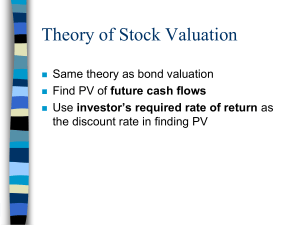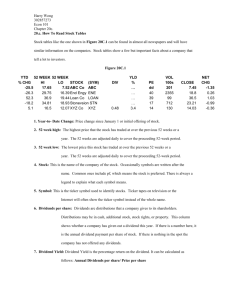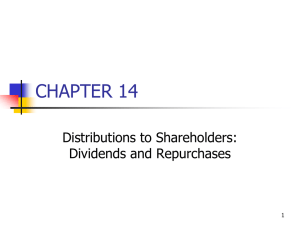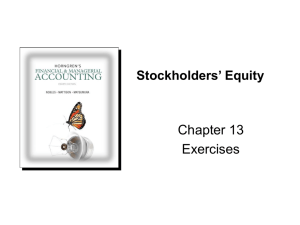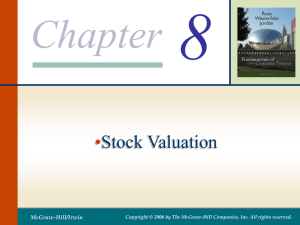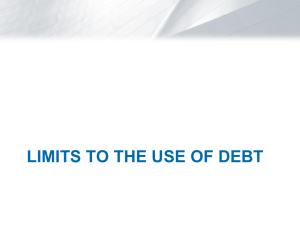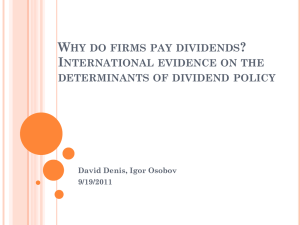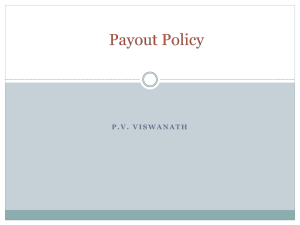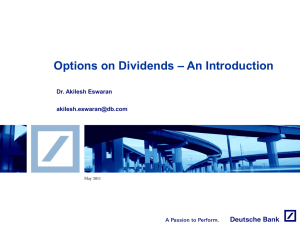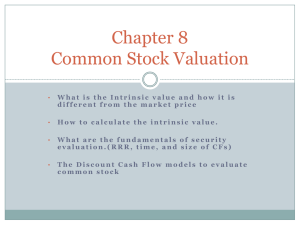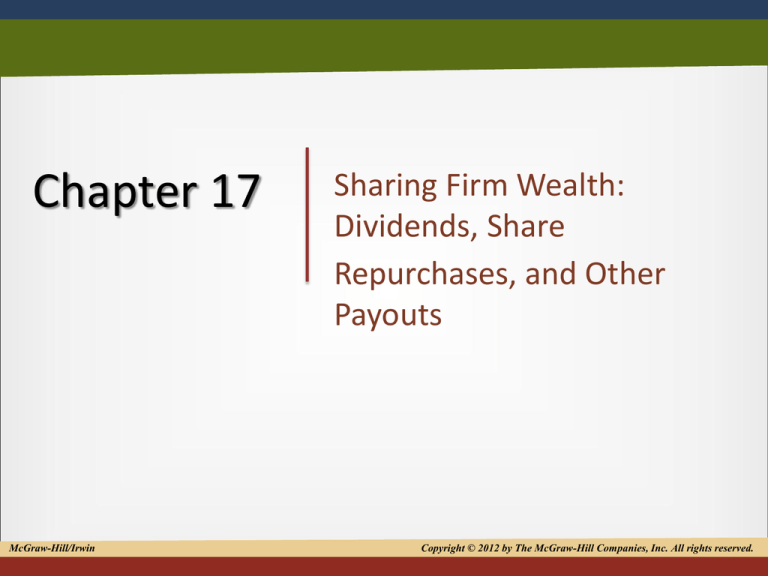
Chapter 17
McGraw-Hill/Irwin
Sharing Firm Wealth:
Dividends, Share
Repurchases, and Other
Payouts
Copyright © 2012 by The McGraw-Hill Companies, Inc. All rights reserved.
1
Copyright © 2012 by The McGraw-Hill Companies, Inc. All rights reserved
Introduction
• Taxation of capital distributions
– Different treatments for capital gains versus dividends
and interest payments
– Differing tax rates for shareholders
17-2
Dividends versus
Capital Gains
• Use the constant growth formula to choose
between paying cash dividend or stock
repurchase
17-3
Dividends versus
Capital Gains
Firms that pay out high percentages of current
earnings have less capital to fund future
growth
17-4
Dividends versus
Capital Gains
• Firms that keep more retained earnings have less
to pay current dividends
• Recommend firms retain earnings to extent they
can make project investments with as high return
as investors could earn elsewhere at similar risk
17-5
Dividend Irrelevance Theory
• Modigliani and Miller
• In perfect world the decision to pay or not to
pay dividends does not matter
17-6
Dividend Irrelevance Theory
• Reminder: The “perfect world” assumes
– No taxes
– No transaction costs
– Perfectly competitive markets
– Completely rational investors
17-7
Dividend Irrelevance Theory
• In M&M’s “perfect world,” paying dividends reduces
each share’s value by the dividend amount
• If the firm chooses not to pay dividends, investors
who want dividends can sell their shares to realize
income not supplied by dividends
17-8
Dividend Irrelevance Theory
• In 2003, tax rates on capital gains and most
dividends lowered
• Dividends now more attractive relative to
capital gains
17-9
Why Some Investors Favor
Dividends
• Bird-in-the-hand theory
– Dividends less risky, more attractive to risk-averse
investors than future capital gains
• Bird-in-the-hand fallacy
– Most investors invest dividends in similar firms
– Firm’s risk profile determined by asset cash flows
not dividend payout policy
17-10
Why Some Investors
Favor Capital Gains
At the same tax rates, capital gains have
potential tax advantages over dividends
– All shareholders pay taxes on dividends
– Only selling shareholders incur taxes on realized
capital gains when a growing firm retains earnings
17-11
Other Dividend Policy Issues
• Tangible effects
– Risks
– Taxation
– Cash flow timing
• Also intangible effects
17-12
The Information Effect
• Firms hesitate to increase dividends unless
they can be maintained
• Analysts interpret dividend increases as
positive signal about firm’s future cash flows
17-13
The Clientele Effect
• Investors (clientele) have different desires
about taxability and timing of firm payouts
• Payout policies of different firms attract
different investor groups
17-14
Corporate Control Issues
• Shareholders with large stakes in the firm may
dictate dividend payout policy
• Closely-held companies may retain more
earnings as owners try to minimize the effect
of double taxation
17-15
Real-World Dividend Policy
• Basic dividend policy
– Pay out surplus cash flow as dividends after
investing in positive net present value projects
17-16
The Residual Dividend Model
• Also known as the free cash flow theory of
dividends
• Assumes that cash flow, beyond that needed
to invest in positive NPV projects, is paid out
as dividends
17-17
Extraordinary Dividends
• Firms divide dividends into two classes to
manage
1) Ordinary dividends (relatively low)
2) Extraordinary dividends (periodic, extra)
• Firms forego extraordinary when needed
17-18
Dividend Payment Logistics
• Declaration date
– Board of directors announces intention to pay a
dividend
– Firm records the liability on its books
• Ex-dividend date
– The first day that shares trade without dividend
attached
17-19
Dividend Payment Logistics
• Record date
– Firm identifies the owners of record to begin
addressing payments
– Record date is set several business days after exdividend date to allow time for registration
process
• Payment date
– Firm sends out the dividends
17-20
Effect of Dividends on Stock Prices
• Stock prices increase as the next dividend
approaches
• Stock prices fall by the present value of the
dividend once the stock goes ex-dividend
17-21
Stock Dividends
and Stock Splits
• Both increase shares outstanding without
changing total market value of owner’s equity
• Both will decrease the stock price
17-22
Stock Dividends
• Pro-rata distribution of new shares to current
stockholders
– Example: A 20 percent stock dividend would
increase the number of shares held by each
shareholder by 20 percent
17-23
Stock Splits
• Company exchanges new shares for old shares
• Each old share usually converts into more than
one new share
17-24
Stock Splits
• Alter par value of firm’s stock on company’s
books
• Do not cause shift in owner’s equity accounts
17-25
Effect of Splits and Stock
Dividends on Stock Prices
• Firms want shares to trade in price range
– Stock dividend or split brings stock price back in
range
• Investors like to trade in 100 share “round
lots”
17-26
Stock Repurchases
• Firm buys shares of own stock on stock
exchange like any investor
– Open-market stock repurchase
– May take months or years
17-27
Advantages of Repurchases
• Can offer an efficient way to return money to
shareholders
• Reduction or cessation of repurchases not
seen as a negative
17-28
Disadvantages of Repurchases
• Can make firm vulnerable to litigation from selling
shareholders
– Management may have undisclosed information about
good future prospects for firm
• Overpayments for shares result in share dilution
• IRS penalties if proven the repurchase was primarily
to avoid dividend taxation
17-29
Effect of Repurchases on
Stock Prices
– Advantages outweigh the disadvantages
– Repurchasing companies produce significant
excess returns for several years after repurchase
17-30

